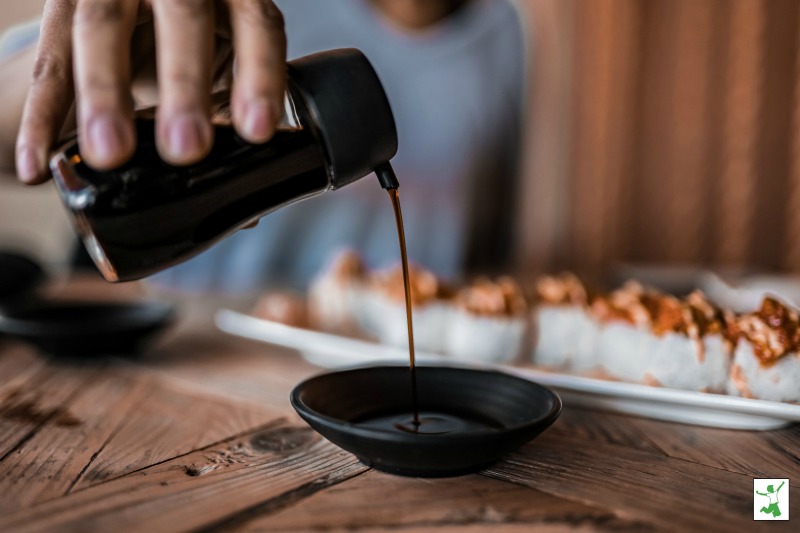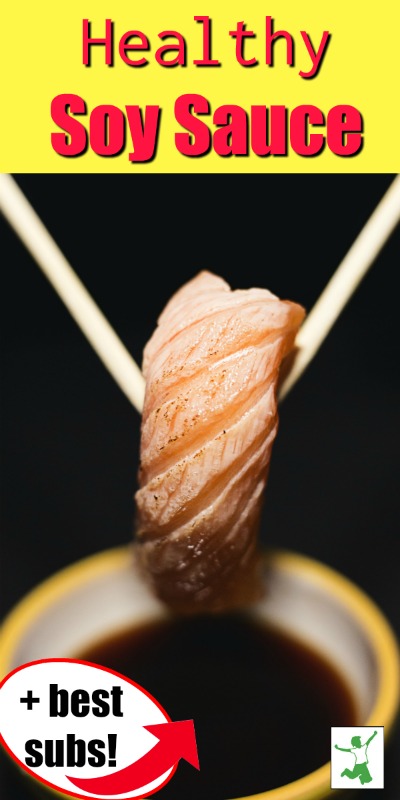What to look for when sourcing healthy soy sauce to obtain all the health benefits from the traditional brewing process and which substitutes are best to use if you are allergic to soy or avoiding grains.

Soy sauce, also commonly known as shoyu, is the best-known flavor enhancer in Asian cooking. Made the old-fashioned way — through a careful fermentation process that can take as long as 18 months — it’s a healthy and nourishing product.
The best quality, truly healthy brands of soy sauce are not only fermented in a traditional manner but also unpasteurized to retain beneficial enzymes and nutritional cofactors.
Tamari is a variant that is made only with soybeans (without any wheat). As far as I know, all the brands of tamari and most brands of shoyu sold in health food stores have been pasteurized. Though not optimal, these are far superior to the commercial soy sauces sold in supermarkets and used by the restaurant industry.
The Scary Truth About Commercial Soy Sauce
The most common soy sauces sold in supermarkets and served at the majority of restaurants are made in two days or less. Here’s how they do it.
If you really love your takeaway, you might want to sit down for this.
Soybean meal and often corn starches are rapidly reduced to their component amino acids using a high-tech process known as “rapid hydrolysis” or “acid hydrolysis”. This involves heating defatted hydrolyzed soy protein with eighteen percent hydrochloric acid for 8 to 12 hours, then neutralizing the brew with sodium carbonate. The result is a dark brown liquid — a chemical soy sauce.
When mixed with some genuine fermented soy sauce to improve its flavor and odor, it is called a “semi-chemical” soy sauce. Sugars, caramel colorings, and other flavorings are added before further refinement, pasteurization, and bottling.
The rapid hydrolysis method uses the enzyme glutamase as a reactor. This creates large amounts of an unnatural form of glutamic acid that closely resembles that found in MSG. In contrast, the production of genuine old-fashioned soy sauce uses the enzyme glutaminase to form naturally occurring glutamic acid.
Other undesirables that appear during chemical hydrolysis are levulinic and formic acids, instead of beneficial lactic acid, and the gas produces dimethyl sulfide, hydrogen sulfide and furfurol from the amino acid methionine. The hydrolysis process also results in the total destruction of the beneficial and essential amino acid tryptophan.
Modern soy sauces may also contain dangerous levels of chemicals known as chloropropanols, which are produced when soy sauce production is sped up using acid hydrolyzation methods. In Great Britain, back in 2001, nearly 25 percent of commercial soy sauces were found to contain dangerous levels of these chemicals, and the products were recalled.
The Australia New Zealand Food Authority also recalled commercial soy sauces for this reason. No recalls occurred in the United States, but because most modern companies use some form of this method and exercise less-than-perfect quality control, the safety of commercial soy sauces cannot be assured.
Researchers have also found furanone in commercial soy sauce. These are mutagenic to bacteria and cause DNA damage in lab tests. Salsolinol, a neurotoxin linked to DNA damage and chromosomal aberrations, Parkinson’s disease, and cancer, has been identified in soy sauce.
Ethyl carbamate — also linked to cancer– is found in commercial samples of soy sauce, light and dark miso and some alcoholic beverages. The maximum concentrations observed were 73 mcg per kg in soy sauce compared to the tiny amount of 7.9 mcg per kg found in miso.
Don’t Use Commercial Soy Sauce if on MAOI Drugs
Soy sauce also contains a high content of the amino acid tyramine, a potent precursor of mutagens produced by nitrites. The tyramine content makes this product unsuitable for people taking monoamine oxidase inhibitors (MAOI) drugs, which are commonly prescribed for depression, migraines, and high blood pressure.
The best-known tyramine rich foods are aged cheeses, red wines, smoked and pickled herring, and beer. Eating any of these foods — including tyramine rich soy sauce — while taking MAOI drugs can bring on an episode of high blood pressure accompanied by severe headache, palpitations, and nausea.
Healthy Soy Sauce
So for truly healthy soy sauce, get the genuine old fashioned fermented raw stuff.
Less optimal but still fine for most people are small amounts of health food store brand, pasteurized tamari, and shoyu.
Best (and worst) Soy Sauce Substitutes
Are you allergic to soy that is fermented or do you avoid grains in general?
Then, the best alternative to soy sauce is coconut aminos. This product is available either fermented or unfermented.
If sensitive to histamines or glutamate, choose unfermented coconut aminos (source).
Avoid Liquid Aminos
Think a liquid aminos soy sauce substitute would be healthier?
Think again!
Liquid aminos are an unfermented liquid soy product invented by health food pioneer Paul Bragg and is a soy sauce alternative preferred by many health aficionados. Its main claim to fame has been a lower sodium content than tamari or shoyu. Given that salt has been unjustly maligned as unhealthy, this may not even be desirable.
In any case, lower-sodium does not mean low, and the company responsible for manufacturing liquid aminos was warned in 1996 by the FDA that it’s “no salt” label was misleading and it’s “healthy” claim was unwarranted given its high sodium levels.
The company was also told to cease and desist using its “No MSG” claim. As a hydrolyzed protein, liquid aminos contain plenty of MSG produced as a residue of the hydrolyzing process. It also contains aspartic acid, another brain-damaging excitotoxin, which is a component of aspartame as well.
The takeaway: No bragging rights for liquid aminos!

More Information
Soy Lecithin: Really So Unhealthy?
Estrogenic Foods Like Soy Trigger Precancerous Breasts
Is Your Egg Allergy Really a Soy Allergy in Disguise?
170 Scientific Reasons to Eliminate Soy from Your Diet
Soy Formula is Harmful to a Child’s Development








In general, I agree, BUT when you start having problems with an ingredient that changes! I have started severe migraines with aura and I have traced them to eating foods that contain MSG. Moderation is no longer an option And I have found the food industry uses other names to disguise it.
If you’re looking for an unpasteurized soy sauce, try Swiss Soyana Nama-Tamari.
Hi, what would be a healthy way to make soy sauce yourself? How do you know which recipe is the right one?
Healthy soy sauce is fermented for long periods of time. Buying it from companies that produce it in a traditional manner is a good idea.
I’m shocked to see that Bragg Liquid Aminos HAS MORE SODIUM than reduced-sodium tamari!!
Bragg liquid aminos 1/2t = 160 mg sodium = 320 mg sodium per teaspoon = 960 per Tablespoon (vegetable protein from soybeans and purified water)
Organic Tamari Reduced Sodium 700mg per Tablespoon (Water, Organic Soybeans, Salt, Organic Alcohol (to preserve freshness)
San-J Organic Reduced Sodium Gluten Free Tamari Soy Sauce 1T = 700 mg (Water, organic soybeans, salt, and organic alcohol (to preserve freshness).
Simple Truth® Organic Tamari Sauce Reduced Sodium 700 mg per T (Water, organic soybeans, salt, organic alcohol (to preserve freshness)
I have the Bragg bottle in front of me. Going to start filling the container with water to dilute it until I finish it. Then I’ll switch to reduced-sodium tamari.
I use a lot of soy sauce and coconut aminos in my cooking, and on my vegetable fried rice for lunch, on a regular basis. Based on this information, I would like to replace it with another “healthy” sauce. Does anyone know of a healthy substitute. Thank you!
I believe we should eat a balanced diet. I don’t think people actually eat a lot of soya sauce in one sitting every day. Besides, if you check every food item for ‘unhealthy’ reasons not to eat, you will find each one successfully. Life is short and it seems everything we eat today are linked to some kind of sickness. People/manufacturers/importers can put any description on the label, you can’t check on everything. Some touted as ‘organic’ are just not, and with highly inflated prices. Not everyone can afford ‘organic’ food, especially not the average or poorer community. As long as you know they are not poison, and you are not allergic to it, I feel there is really no reason to avoid it. But if you can afford really good and expensive stuff, by all means, enjoy it, but don’t go overboard! Going overboard with any food is what makes you sick.
If you are looking for “good old real sauce” Kikkoman is the way to go! Kikkoman produces very high quality and real soysauce that takes months of love and care to create!
I looked into these liquid amino acids as a low-salt replacement for soy sauce.
I don’t know who’s lying, but these amino acids have as much sodium as soy sauce. Anyone needing to reduce their sodium intake can’t use this stuff.
This is an old article so I am not sure if I’ll get a response or not, but I am allergic to soy but I have been able to eat “store bought” soy sauce with no issues. Does anyone know if getting the raw, unpasteurized kind makes it more likely to trigger my allergies? My reactions are tied to soy protein, because soy sauce, soy lecithin, and soy oil don’t bother me the same way (though I try to avoid the oil and lecithin anyway).